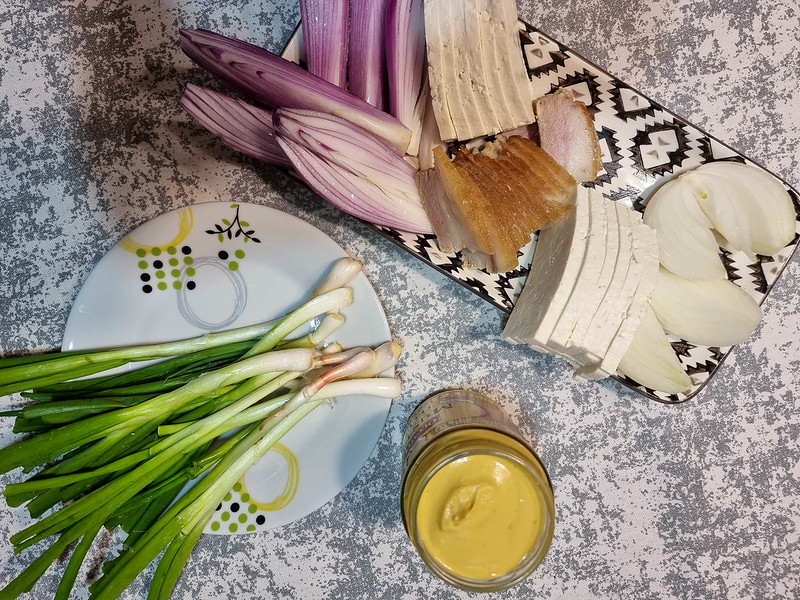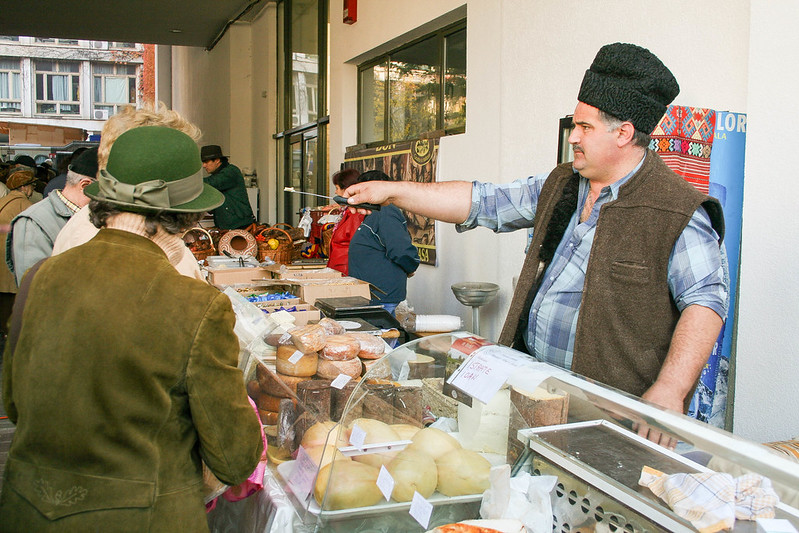Today I would like to talk to you about the delicious Romanian cheese that I grew up with. There are a few types of traditional Romanian cheese that you won’t find anywhere else in Europe. And, if you find anything similar, they certainly won’t taste the same.
Cheese plays a very important role in Romanian cuisine. It has always been a staple in our gastronomy, it dates back to Romanian was called Dacia, at the beginning of the first millennia. Back then, the Dacians used to cook it with olive oil and sweet white wine. As the Roman Empire expanded and Dacia was conquered, the Roman’s knowledge of how to make cheese subsequently spread across the country.
More recently, cheese has always been part of the daily farmers’ lunches, alongside raw onion and smoked lard, when they went to the fields to work their land.
Romania produces six different types of traditional cheeses:
- Telemea
- Branza de Burduf
- Cascaval
- Cas
- Urda
- Branza de Vaci
Branza Telemea – Telemea Cheese

Telemea is one of the most popular Romanian cheeses. It is a fresh type of cheese, salty, made from different types of milk. There is cow milk telemea, sheep milk telemea, goat milk telemea, even buffalo milk telemea – which is a speciality. Some telemea cheeses are made from a combination of milk, most often cow and goat, or cow and sheep.
Whilst you can easily buy telemea cheese from the supermarket, the best is still made by local producers and sold in farmers markets around Romania. When you buy cheese in the farmers market you will notice that most of the time it is kept inside big barrels, in its own brine. You can always taste the cheese in the farmers market, to see if you like it or not.
The telemea cheese has a salty taste and is somehow similar to feta, but with a much crumblier texture. In the market, there are never two producers that make the same cheese, and this is because everyone has their own recipes for the brine. Sometimes, if the cheese is too salty, you can put it in water at home, to reduce the amount of salt.
Telemea is a fresh cheese that is usually eaten on its own, usually alongside a breakfast or lunch spread with other products such as bell peppers, tomatoes, onions, and bread with zacusca. It is also used in traditional Romanian recipes such as cheese pies like merdenele or in pancakes with cheese and dill.
Branza de Burduf

Branza de burduf is an odd one. This Romanian cheese is made from unpasteurized sheep’s milk and it’s aged inside the animal’s stomach to mature. It has a salty taste and a very creamy texture. To eat it, you have to scoop out the cheese from inside its packaging.
Another way to age the burduf cheese, which adds a lot of flavour to it, is in tubes made from fir bark rather than the sheep’s stomach. The cheese is aged for 2-3 months, to infuse with that woody, spicy aroma of the bark.
These days though, when you buy the cheese from the supermarket, you will find it sold inside plastic tubes rather than a sheep’s stomach. But in my opinion, the best place to buy burduf cheese is the farmer markets around Transylvania, and not the supermarket.
This particular cheese is typical from Transylvania, where it is used to eat as it is, spread on bread, or in recipes such as polenta with cheese, omelettes, or pies with cheese and spinach.
Cascaval

Cascaval is the only Romanian aged semi-hard cheese. It is made from unpasteurized cow and/or sheep milk and has a lovely, smooth texture. It has a nutty taste and it is one of the most popular cheeses in Romania.
You may want to think that the cascaval is similar to cheddar cheese, but it is not, other than in appearance. The taste, the texture, and the entire experience of eating cascaval is very different. Firstly, in my opinion, the best cascaval is the one that has a certain creaminess in it, a nutty flavour and a very soft texture. If the cascaval is too hard or too salty, I don’t like it.
Cascaval is the cheese that we use to make fried cheese, because of its high melting point. The fried cheese is a delight, it has a crunchy taste and a fantastic stretchy middle – similar with baked mozzarella but with plenty of flavour.
Besides the classic six months old aged cascaval, in Romania you will also find smoked cascaval. This is a delight and a local speciality. It usually comes braided and has a beautiful golden colour.
Cas

Cas is a very young cheese that stands at the base of telemea and cascaval. It is made by adding rennet to the milk and separating the liquid from the whey. This is a soft cheese with a smooth texture, with a very mild taste.
Usually you will only find cas in the farmers market, and not in the supermarket. This is because if the cas is aged, it will turn into a different type of cheese.
The best way to eat cas is fresh, alongside a nice breakfast spread. It’s a great, light cheese to be enjoyed in summer, when it’s very hot in Romania.
Urda

Urda is another fresh, Romanian cheese. It has a mild taste and a soft texture and it is mostly used for traditional Romanian dessert fillings.
Urda is similar to Italian ricotta, and it’s mostly made from sheep milk.
Branza de Vaci

Branza de Vaci is a gem among the other Romanian cheeses. Whilst on its own it doesn’t have much flavour and the texture is dry and very crumbly, it is an important element of many Romanian traditional desserts, such as the classic papanasi or the sweet cheese pie.
Branza de Vaci translates as cottage cheese. However, it is very different from the English cottage cheese, which usually has cream in it as well. The Romanian branza de vaci is fresh and can easily be mixed to form a paste – essential for desserts. The closest product it is similar to is quark.
Cottage cheese is made from whole cow milk, it is soft and has a very mild saltiness.
Where Can You Buy Romanian Cheese?

If you want to try Romanian cheese but don’t live in Romania, you can always look for Romanian or Polish shops around your area. Also, sometimes the Turkish shops will also have it.
When you visit Romania and want to try some really good Romanian cheese, you must go to the farmers market. Every city has a central market where farmers come to sell their produce, which is open every day until about 4PM.
For more articles about the Romanian cuisine, check out the following:
- The most delicious Romanian foods
- The most delicious Romanian soups
- The most delicious Romanian desserts
Like it? Pin it!





